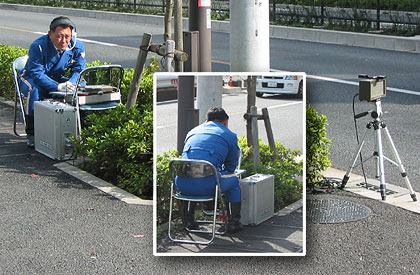That’s The Ticket

In the United States, speed traps are usually cops on motorcycles or in patrol cars, hiding around a corner or behind bushes or other cover–usually a one-man operation. In Japan, they work in teams. I was able to observe one in action today, not too far from a station I use.
Here’s how it works: one cop, in this case, shown in the photo at top, finds a spot–usually behind signposts and/or telephone poles–and sets up shop. The radar detector goes out front, and the policeman, working with the control gear out of a metal suitcase, hides crouching on a chair behind his cover. He is in radio contact with a team of fellow officers about two blocks away. The team is  located strategically so that a speeder cannot turn off somewhere or otherwise get by. A motorcycle cop stands ready to pursue anyone who tries to get away.
located strategically so that a speeder cannot turn off somewhere or otherwise get by. A motorcycle cop stands ready to pursue anyone who tries to get away.
The cop in the chair detects someone going too fast. His gear displays the speed, and it radios the signal to the first guy’s counterpart (see bottom photo, guy sitting on a similar chair). The team gets a warning shout over radio from the guy up front, telling them that a speeder has just passed by. The team dispatches a pair of policemen–one regular cop, and one motorcycle cop–into the street to flag down the driver, and pull them into a nearby parking area (I caught the tail end of this in the photo at middle right). The driver is then taken to a folding table with chairs set up where seated officers get their information, give them a lecture, and write out the citations.
In the times I have seen this setup, I have noted that it is never in a place where speeding might be a problem. I know of many streets–a few right in front of police stations, no less–where the hazards are great: speeding cars, blind corners, pedestrians crossing at all places, the  works–and there is never a speed trap or even an officer on patrol. In the places where they could do the most good. Instead, the traps are set up on long, wide straightaways with absurdly low speed limits. The street pictured here is a wide (for Japan) two-lane boulevard with little foot traffic (it’s an industrial area). I walked its length and maybe saw one or two pedestrians in total. Very little cross traffic. In other words, probably the place one would least have to worry about accidents happening.
works–and there is never a speed trap or even an officer on patrol. In the places where they could do the most good. Instead, the traps are set up on long, wide straightaways with absurdly low speed limits. The street pictured here is a wide (for Japan) two-lane boulevard with little foot traffic (it’s an industrial area). I walked its length and maybe saw one or two pedestrians in total. Very little cross traffic. In other words, probably the place one would least have to worry about accidents happening.
And the speed limit is 40 kph, or 25 mph. This kind of street would be at least a 45 mph (70 kph) zone in the U.S. For the type of street it is, the speed limit is ridiculous. And so, naturally, everyone speeds. I believe that this is called “shooting fish in a barrel.”
The few other times I have witnessed speed traps in Japan, they have always been like this. Not for safety, not for public service. But for the sole purpose of writing out tickets. If this were a sometimes thing, like in the U.S., it wouldn’t be so bad. But from what I have witnessed, traffic cops never give out tickets for the purpose of safety. Just for revenue. And that’s completely wrong. These police should be at the dangerous locations, making the streets safer. I covered this in a previous entry, “Seasonal Fair-Weather Daylight Enforcers,” though I did not have artwork on the speed traps at the time. But the criticism still stands. It is almost emblematic of Japanese police, traffic or otherwise, to make more of a show than to actually keep the peace. They can do much better than this.

I see a similar thing here in Indiana during the last week of every month. The police are out trying to get their ‘quotas’ (of course they say they don’t have quotas) but you usually see a ton of speed traps in ‘barrels’ such as the one you talk about. Ir’s pretty much all for revenue.
I read an interesting article once a few years ago that said the 55MPH speed limit was put in place here during the gas shortage but never lifted when the shortage did because cities and states got so much revenue enforcing the lower limits they didn’t want to give it up.